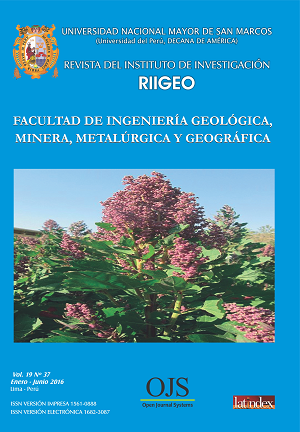Evaluation of nutritional supplements on solid substrates for mass production of Beauveria bassiana (balsam) Vuillemin and native Metarhizium anisopliae (Metschnikoff) Sorokin in the laboratory
DOI:
https://doi.org/10.15381/iigeo.v19i37.12951Keywords:
Entomopathogenic fungi, biocontrol, solid substrates, nutritional supplements, mass production, solid fermentation, conidia, bioproductAbstract
In mass production, the carbon nitrogen (C: N) ratio affects the growth and production of conidia. The objective was to evaluate B. bassiana and M. anisopliaenativos in solid substrates rice (Oryza sativa L.) and corn (Zea mays L.) enriched with nutritional supplements, molasses (source-carbon) in concentration (2.5-5.0 g ), amaranth and soybean meals, milk powder and yeast (nitrogen sources) of concentration (0.25-0.50 g), compared with controls. The C: N ratio was 10: 1. The experimental design was Categorical Multi-Factorial and the technique, observation. The mass production of fungi was solid fermentation in 40 treatments with 3 repetitions; the count of conidia in the Neubauer chamber; and, the analysis of results with Statgraphics Plus-Ver.5.1, IBM-SPPS-Ver.22 and Excel-2013. The best production of B. bassiana in rice was T13 (molasses-2.5 and milk-0.25) g with an average of 1.89 × 10 9 conidia / g; and, in M. anisopliaeel T14 (rice-molasses-0.25 and milk-0.25) and average 1.86 × 109 conidia / g. The lowest production of B. Bassianaen T19 (rice-molasses-0.5 and yeast-0.5) g with 1.28 × 109 conidia / g; and, M. anisopliaeen T2 (control) with 1.40 × 10 9 conidia / g. The highest yield of B. bassiana in corn was T33 (molasses-2.5 and milk-0.25) g with an average of 2.05 × 10 9 conidia / g and M. anisopliaeen T34 (rice-molasses-2.5 and milk-0.25) g with average 2.50 × 10 9 conidia / g; the lowest in B. bassiana was in T37 (rice-molasses-2.5 and yeast-0.25) g with an average of 1.20 × 10 9 conidia / g and M. anisopliaeen T38 (rice-molasses-2.5 and yeast-0.25) g with average 1.39 × 10 9 conidia / g. The ADEVA registered significant statistical differences at ≤p 0.05 in SS, SN and interactions AB and BC; similarly, in the multiple comparison of means with Tukey (95% confidence level) in the groups and within these for substrate-molasses-milk. It is concluded that the addition of SN to SS rice and corn for the mass production of HEP B. Bassianay M. Anisopliaea laboratory scale influenced the yield of conidia / g, reaching a total mean of 1.64 × 10 9 conidia / g of bioproduct.
Downloads
Published
Issue
Section
License
Copyright (c) 2016 Clemencia Oderay Merino Peñafiel, Oscar Rafael Tinoco Gómez, Myriam Merino Jaramillo, Moisés Arreguín Sámana

This work is licensed under a Creative Commons Attribution-NonCommercial-ShareAlike 4.0 International License.
AUTHORS RETAIN THEIR RIGHTS:
a. Authors retain their trade mark rights and patent, and also on any process or procedure described in the article.
b. Authors retain their right to share, copy, distribute, perform and publicly communicate their article (eg, to place their article in an institutional repository or publish it in a book), with an acknowledgment of its initial publication in the Rev. Inst. investig. Fac. minas metal cienc. geogr.
c. Authors retain theirs right to make a subsequent publication of their work, to use the article or any part thereof (eg a compilation of his papers, lecture notes, thesis, or a book), always indicating the source of publication (the originator of the work, journal, volume, number and date).






